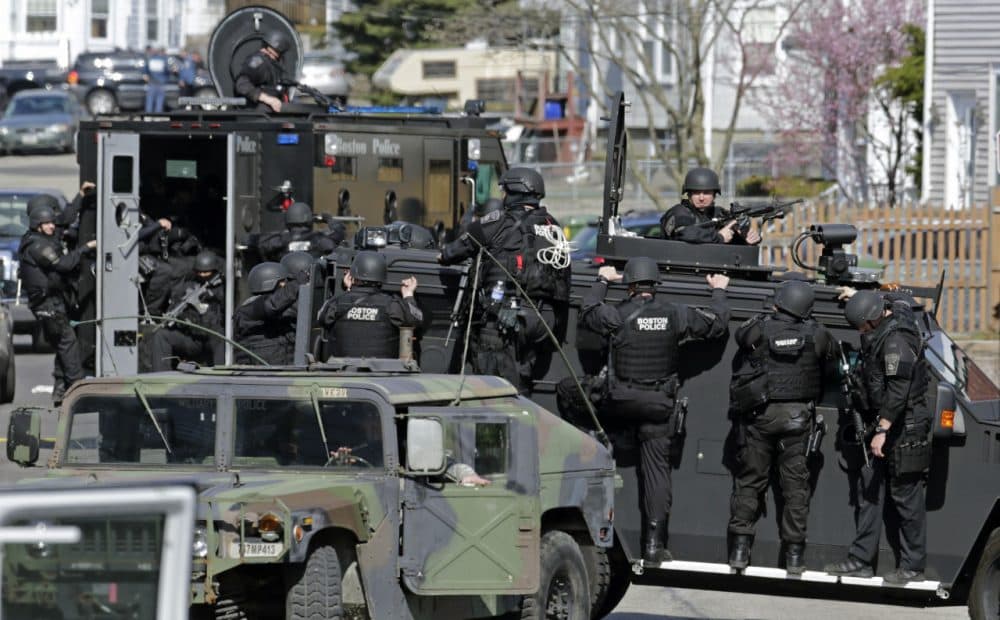Advertisement
Report On Bombing Response Cites Lack Of 'Weapons Discipline' In Watertown Manhunt

Some police officers involved in tracking down the Boston Marathon bombers days after the attacks showed a lack of "weapons discipline" during a firefight with the brothers and in the eventual capture of one of them, resulting in dangerous crossfire, according to a report released Friday.
The 130-page report by the Massachusetts Emergency Management Agency, nearly two years in the making, examined all aspects of the response to the bombing that killed three people and wounded more than 260 others.
A transit police officer, Richard Donohue, was critically wounded in the initial confrontation with Dzhokhar and Tamerlan Tsarnaev on a Watertown street April 19, 2013. The report doesn't say whether Donohue was shot by fellow officers.
The report also reveals that shortly after the shootout, which led to Tamerlan Tsarnaev's death, an officer near the scene fired on an unmarked state police vehicle after it was mistakenly reported as stolen. A state trooper and a Boston police officer in the vehicle weren't injured.
Later in the day, when Dzhokhar Tsarnaev was discovered wounded and hiding in a boat, a police officer "fired his weapon without appropriate authority," causing many other officers to believe the bomber was firing at them and leading them to open fire on the boat, according to the report.
The report praises many other aspects of the emergency response to the April 15, 2013, bombings at the finish line of the marathon, particularly the response of medical personnel at the scene and Boston hospitals who treated gravely injured victims. While three died at the scene, every victim who was transported to a hospital survived.
"Overall, the response to the Boston Marathon bombings must be considered a great success," the report stated.
The shootout with the suspects in Watertown followed the fatal shooting of Sean Collier, a Massachusetts Institute of Technology police officer, and a carjacking in Cambridge.
Advertisement
"Although initial responding officers practiced appropriate weapons discipline while they were engaged in the firefight with the suspects, additional officers arriving on scene near the conclusion of the firefight fired weapons toward the vicinity of the suspects, without necessarily having identified and lined up their target," or appropriately aiming their guns, the report said.
"Officers lining both sides of the street also fired upon the second suspect as he fled the scene in a vehicle," the report went on to state. A timeline of events listed in the report noted that the transit officer was shot as the surviving suspect fled.
The report doesn't name any of the officers from several agencies and jurisdictions that were involved in the Watertown incidents.
There was also a lack of coordination and management of the more than 2,500 law enforcement officers who converged on a staging area at a shopping mall in Watertown during the day, many of whom "self-deployed," according to the report.
Dzhokhar Tsarnaev is on trial on federal charges, some of which could carry the death penalty, related to the bombing and its aftermath. His lawyer admitted in opening statements that he had participated in the bombings but argued that his late brother was the mastermind. Closing arguments are scheduled for Monday.
Middlesex District Attorney Marian Ryan has said she plans to release the findings of her office's investigation into the Watertown firefight within the next couple of months.
A Harvard University report released last year on the marathon bombing response, while largely positive, also said the gunfight lacked coordination and restraint, putting police and the public in danger.
The MEMA report had strong praise for the unified command structure that developed after the marathon attack, saying law enforcement agencies and political leaders worked cooperatively and successfully to make key decisions in the days that followed.
Boston Mayor Marty Walsh said he was proud of the report's findings on the efforts of city workers after the bombing.
"I know that over the past two years city departments have worked together diligently to take the lessons learned from the bombings and drastically improve our emergency response protocols so we are even better prepared for the future, and we can set the example for other cities," Walsh said.
This article was originally published on April 03, 2015.